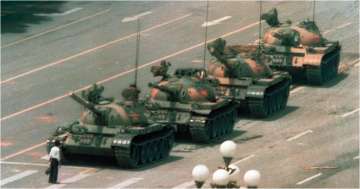One of the famous incidents in the history of the world, the Tiananmen Square protest and its haunting memories which comes down to one picture known as 'Tank Man'. The image of one man standing in the way of a column of tanks, a day after hundreds possibly thousands of people died, has become a defining image of the 1989 pro-democracy protests.
The photographer, Charlie Cole, one of the photographers who captured the famous Tank Man on film during the Tiananmen Square protests in 1989, has died. He was 64. He died last week in Bali, Indonesia, where he had been residing on Friday.
Cole was one of four photographers that captured the image on June 5, 1989, of the man standing in the way of a column of tanks, a day after hundreds possibly thousands of people died. Cole won the 1990 World Press Photo award for his picture which became a defining image of the 1989 pro-democracy protests.
He took his picture for Newsweek with a telephoto lens from the balcony of a hotel, framing it so the man was only just in the bottom left corner. Cole later described how he had expected the man would be killed, and felt it was his responsibility to record what was happening. But the unidentified protester was eventually pulled away from the scene by two men. What happened to him still remains unknown.
'Tank Man': a peaceful resistance
'Tank man' was featured in 'The most influential photos of all times'
When Charlie Cole captured this incident, he knew be would be searched later by Chinese security so hid the undeveloped film roll in the bathroom. After sometime, officials broke through the door and searched the hotel room, but they were not able to discover the film. The scene as shot by him and the other three photographers went on to become an iconic symbol of peaceful resistance across the world.
What happened that day?
A day after the Tiananmen Square massacre, the Chinese troops were attacking the pro-democracy demonstrators camped on the plaza. When Charlie Cole along with other photographers was capturing the bloody victims, passersby on bicycles and the occasional scorched bus, a column of tanks began rolling out of the plaza. Charlie Cole and Jeff Weidner lined up their lens just as a man carrying shopping bags stepped in front of the war machines, waving his arms and refusing to move.
A lone cyclist walks past street barriers on Changan Avenue, crushed by Chinese Army tanks during the Tiananmen Square massacre on June 4.
The tanks tried to go around the man, but he stepped back into their path, climbing atop one briefly. The photographers assumed the man would be killed, but the tanks held their fire. Eventually, the man was pulled away from the scene by two men. What happened to him still remains unknown.
Others also captured the scene, but Widener’s image was transmitted over the AP wire and appeared on front pages all over the world.
Demonstrators sit in front of soldiers standing guard outside the Chinese Communist Party's headquarters on Changan Avenue a few days before the start of the violence. June 1.
What is the Tiananmen Square Protest?
The Tiananmen Square Protest, 1989
The Tiananmen Square Protests which happened in 1989, were a student-led protest demanding democracy, free press and free speech in China. They were halted in a bloody crackdown, known as the Tiananmen Square Massacre, by the Chinese government on June 4 and 5, 1989. The students also argued that China’s educational system did not adequately prepare them for an economic system with elements of free-market capitalism. Some leaders within China’s government were sympathetic to the protesters’ cause, while others saw them as a political threat.
Latest World News
